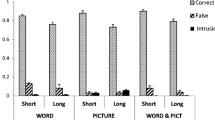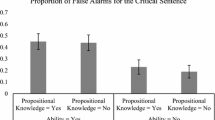Abstract
Proverbs were used to examine recognition memory for four types of sentence information (figurative meaning, literal meaning, lexical information, syntactic information) with two levels of comprehension. Forced-choice recognition tasks showed that subjects were successful in remembering all four types of information. Recognition scores for the figurative meaning of unfamiliar proverbs presented in isolation were above chance and were also significantly improved when procedures were employed which encouraged comprehension of this level of meaning. The results are most consistent with theories of comprehension which provide for different types of processing for figurative and literal language.
Similar content being viewed by others
References
Anderson, J. R. (1974). Verbatim and propositional representation of sentences in immediate and long-term memory.J. Verb. Learn. Verb. Behav. 13:149–162.
Anderson, J. R., and Bower, G. H. (1973).Human Associative Memory, Winston, Washington, D.C.
Anderson, J. R., and Paulson, R. (1977). Representation and retention of verbatim information.J. Verb. Learn. Verb. Behav. 16:439–451.
Begg, I. (1971) Recognition memory for sentence meaning and wording.J. Verb. Learn. Verb. Behav. 19:176–181.
Bobrow, D. G., and Norman, D. A. (1975) Some principles of memory schemata. In Bobrow, D. G., and Norman, D. A. (eds.),Representation and Understanding: Studies in Cognitive Science, Academic Press, New York.
Bransford, J. D., Franks, J. J., Morris, C. D., and Stein, B. S. (1979). Some general constraints on learning and memory research. In Cermak, L. S., and Craik, F. I. M. (eds.),Levels of Processing and Human Memory, Erlbaum, Hillsdale, N.J.
Bühler, K. (1908). Tatsachen und Probleme zu einer Psychologie der Denkvorgänge. III. Über Gedankenerinnerungen.Arch. Gesamte Psychol. 12:93–122.
Bühler, K. (1951). [On thought connections.] In Rapaport, D. (ed. and trans.),Organization and Pathology of Thought: Selected Sources, Columbia University Press, New York.
Clark, H. H. (1973). The language-as-fixed-effect fallacy: A critique of language statistics in psychological research.J. Verb. Learn. Verb. Behav. 12:335–359.
Clark, H. H., and Lucy, P. (1975). Understanding what is meant from what is said: A study in conversationally conveyed requests.J. Verb. Learn. Verb. Behav. 14:56–72.
Collins, A. M., and Quillian, M. R. (1972). How to make a language use. In Tulving, E., and Donaldson, W. (eds.),Organization of Memory, Academic Press, New York.
Davidoff, H. (1946).A World Treasury of Proverbs, Random House, New York.
Grice, H. P. (1975). Logic and conversation. In Cole, P., and Morgan, J. L. (eds.),Syntax and Semantics, Vol. 3:Speech Acts, Academic Press, New York.
Harris, R. J. Comprehension of metaphors: A test of the two-stage processing model.Bull. Psychon. Soc. 8:321–324.
Harrower, M. R. (1933). Organization in higher mental processes.Psychol. Forsch. 17:56–120.
Hayes-Roth, B., and Hayes-Roth, F. (1977). The prominence of lexical information in memory representations of meaning.J. Verb. Learn. Verb. Behav. 16:119–136.
Honeck, R. P. Interpretive versus structural effects on semantic memory.J. Verb. Learn. Verb. Behav. 12:448–455.
Honeck, R. P., Riechmann, P., and Hoffman, R. R. (1975). Semantic memory for metaphor: The conceptual base hypothesis.Memory Cogn. 3:409–415.
Honeck, R. P., Sowry, B. M., and Voegtle, K. (1978). Proverbial understanding in a pictorial context.Child Dev. 49:327–331.
Johnson-Laird, P. N., and Stevenson, R. (1970). Memory for syntax.Nature 227:412.
Katz, J. J., and Fodor, J. A. (1963). The structure of a semantic theory.Language 39:170–210.
Kintsch, W. (1972). Notes on the structure of semantic memory. In Tulving, E., and Donaldson, W. (eds.),Organization of Memory, Academic Press, New York.
Kintsch, W. (1974)The Representation of Meaning in Memory, Erlbaum, Hillsdale.
Kolers, P. A., and Ostry, D. J. (1974). Time course of loss of information regarding pattern analyzing operations.J. Verb. Learn. Verb. Behav. 13:599–612.
Matthews, R. J. (1971). Concerning a “linguistic theory” of metaphor.Found. Lang. 7:413–425.
Morris, C. D., Bransford, J. D., and Franks, J. J. (1977). Levels of processing versus transfer appropriate processing.J. Verb. Learn. Verb. Behav. 16:519–533.
Ortony, A. Beyond literal similarity. In Ortony, A. (ed.),Metaphor and Thought, Cambridge University Press, Cambridge (in press).
Ortony, A., Reynolds, R. E., and Arter, J. A. (1978a). Metaphor: Theoretical and empirical research.Psychol. Bull. 85:919–943.
Ortony, A., Schallert, D. L., Reynolds, R. E., and Antos, S. J. (1978b). Interpreting metaphors and idioms: Some effects of context on comprehension.J. Verb. Learn. Verb. Behav. 17:465–477.
Perfetti, C. A., and Garson, B. (1973). Forgetting linguistic information after reading.J. Educ. Psychol. 65:135–139.
Perrine, L. (1971). Four forms of metaphor.College Eng. 33:125–138.
Pullar-Strecker, H. (1954).Proverbs for Pleasure, Christopher Johnson, London.
Richards, I. A. (1965).The Philosophy of Rhetoric, Oxford University Press, New York.
Sachs, J. S. (1967). Recognition memory for syntactic and semantic aspects of connected discourse.Percept. Psychophys. 2:437–442.
Sachs, J. S. (1974). Memory in reading and listening to discourse.Memory Cogn. 2:95–100.
Trembath, A. A. (1972). Comparison of sensitivity to the surface and deep structure of sentences in children.Lang. Speech 15:51–57.
Verbrugge, R. (1977). Resemblances in language and perception. In Shaw, R., and Bransford, J. (eds.),Perceiving, Acting, and Knowing, Erlbaum, Hillsdale, N.J.
Verbrugge, R. R., and McCarrell, N. S. (1977). Metaphoric comprehension: Studies in reminding and resembling.Cogn. Psychol. 9:494–533.
Weinreich, U. (1966). Explorations in semantic theory. In Sebeok, T. A., (ed.),Current Trends in Linguistics, Vol. 3:Theoretical Foundations, Mouton, The Hague.
Author information
Authors and Affiliations
Rights and permissions
About this article
Cite this article
Kathryn Bock, J., Brewer, W.F. Comprehension and memory of the literal and figurative meaning of proverbs. J Psycholinguist Res 9, 59–72 (1980). https://doi.org/10.1007/BF01067302
Received:
Issue Date:
DOI: https://doi.org/10.1007/BF01067302




